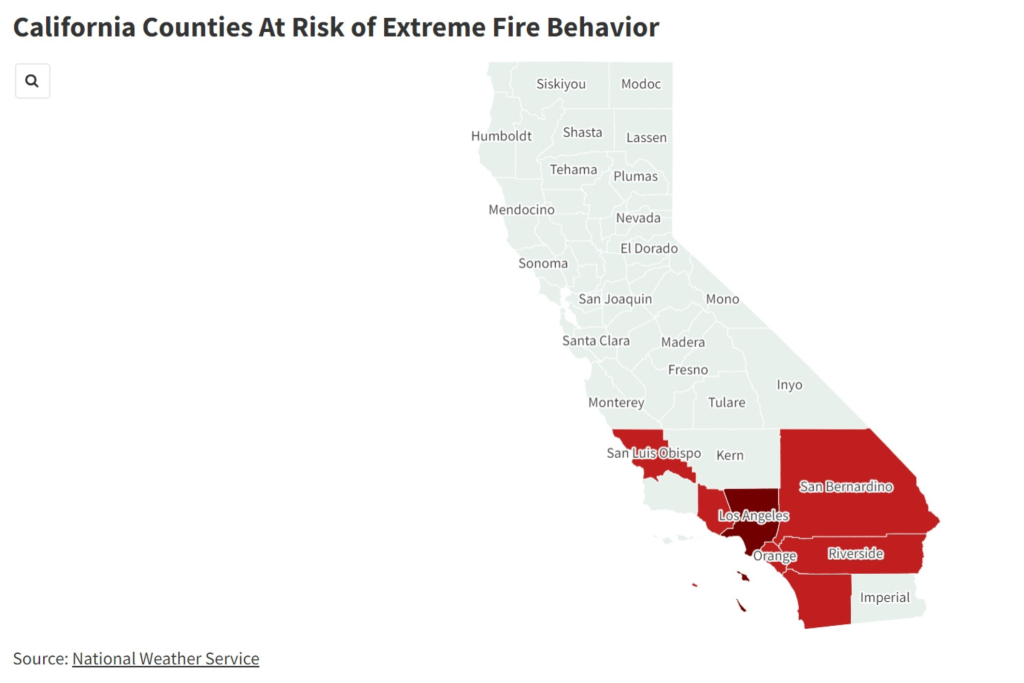The pervasive threat of wildfires continues to loom large over Southern California, with red flag warnings blanketing the region on Tuesday. These warnings, issued by the National Weather Service (NWS), underscore the volatile combination of tinder-dry vegetation and powerful Santa Ana winds, creating an environment ripe for rapid fire spread and extreme fire behavior. This perilous scenario has already manifested in the Franklin Fire, which erupted near Malibu late Monday night and quickly exploded to encompass 2,200 acres, forcing evacuations and demanding a swift response from firefighting crews. The NWS anticipates these dangerous conditions to persist, with the strongest winds expected Tuesday morning, further exacerbating the fire risk.
The critical fire weather conditions extend across a wide swathe of Southern California, encompassing seven counties: Orange, San Luis Obispo, Ventura, Los Angeles, San Bernardino, Riverside, and San Diego. The NWS has pinpointed specific areas of heightened concern, including the San Gabriel Mountains, Santa Susana Mountains, western Santa Monica Mountains into Malibu, Ventura County valleys, western San Fernando Valley, and the hills above Camarillo extending into eastern Ventura. Low relative humidity, plummeting to single digits in some locations, further intensifies the fire danger, creating an environment where any spark could quickly escalate into a raging inferno.
The severity of the current fire threat draws unnerving parallels to notorious historical fires like the Mountain and Thomas Fires, underscoring the potential for widespread devastation. The NWS forecasts the persistence of these dry offshore conditions into Thursday morning, with the prospect of some relief arriving in the afternoon with the return of onshore flow and a slight increase in humidity. Until then, the region remains on high alert, bracing for the possibility of new ignitions and the rapid fire growth they could trigger. Residents within the red flag warning areas are strongly urged to refrain from any outdoor burning and to exercise extreme caution to prevent any potential ignition sources.
Beyond the immediate threat of wildfires, the powerful Santa Ana winds also pose significant secondary risks. Strong gusts, reaching hurricane-force speeds of up to 70 mph in some areas, have the potential to down trees and power lines, leading to widespread power outages and disrupting transportation networks. As of Tuesday afternoon, over 62,000 customers across California were without power, with San Diego County bearing the brunt of the outages. The California Department of Transportation has implemented traffic diversions in certain areas to mitigate the hazards posed by the intense winds.
The ongoing fire threat underscores the vital importance of preparedness and vigilance. Residents in high-risk areas should stay informed about the latest weather updates and fire warnings, have evacuation plans in place, and create defensible space around their homes. Fire agencies are on high alert, strategically positioning resources and personnel to respond swiftly to any new fire outbreaks. The collective efforts of firefighters, emergency responders, and residents will be crucial in mitigating the potential devastation of these extreme fire conditions.
The combination of prolonged dry conditions, powerful Santa Ana winds, and low humidity has created a perfect storm for wildfires in Southern California, necessitating the ongoing red flag warnings. The rapid spread of the Franklin Fire serves as a stark reminder of the destructive potential of these conditions. As the region grapples with this ongoing threat, vigilance, preparedness, and a collective commitment to fire safety will be paramount in protecting lives and property. The potential for widespread power outages and transportation disruptions adds another layer of complexity to the situation, requiring residents to be adaptable and resilient in the face of these challenging circumstances.










